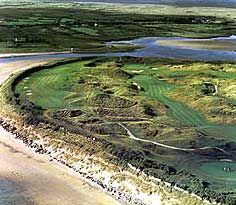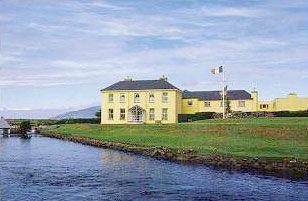Waterville Golf - An Irish Golf Adventure

After playing Tralee, my next stop was Waterville. From Tralee, I took the southern leg of the Ring of Kerry out of Killarney for the 45-mile drive to the course. The drive starts in the valley in Killarney and takes you up through Maine-like forests over a twisting road with frequent hairpin turns. Periodically, through the trees I could see the valley and the lower lake receding below and the MacGilluycuddy's Reeks looming overhead. Above the tree-line some 1,000 feet up the terrain resembled the chaparral country of our West. At the halfway point, the Ring begins to descend to the coast over a very narrow road that runs through a series of small towns, including Sneem, one of the most picturesque villages you'll encounter in Ireland. From there, it's another half hour to Waterville on the far western end of the Iveragh Peninsula.
The town and the golf club of Waterville lie on Ballinskelligs Bay, a wide semi-circular bay enfolded on the north by a sizable jut of the peninsula at the end of which is Bolus Head. At the bay's southern rim is a much smaller jut where Derrynane National park is located. To the east stretching as far as the eye can see are the Skelligs, coastal mountains that offer a fabulously scenic backdrop. Protected by the headlands as it is on the north and south, Waterville doesn't get the full brunt of the sea's violence. As a result, the dunes here are not as high as in, say, Ballybunion.
The origins of golf in Waterville date back to the 1880's when hundreds of technicians descended on the area to build cable stations for the first trans-Atlantic cable between the U.S. and Great Britain. A crude course was laid out and used primarily in winter when the grasses died down. By 1900, the Waterville Athletic Club was formed, becoming one of the first affiliates of the Golfing Union Of Ireland. In 1927, the sale of the local cable company to International Telephone & Telegraph was initiated and Charles Lindbergh, on his inaugural trans-Atlantic solo flight, flew low over the village and waved to the cheering crowd before going on to Paris.
For four decades following World War II, the golf club was dormant until Irish-born New Yorker John Mulcahy had a vision in the late '80s to build a world-class links in Waterville. He hired Ireland's own Eddie Hackett and past Masters champion and pro at Winged Foot Claude Harmon to produce a routing plan. Lying just one mile north from the town center immediately in back of a wide, white beach and offering spectacular sea and mountainous scenery, the layout, which incorporated the original 9 hole course on the front side, is a par 72, 7,200-yard (6,600 from the middle tees) links-style course that drew the highest accolades from the world's best golfers.
The front side is flat veering toward the mountains at a distance to the East. The first two opening holes are straight and narrow and not distinguished except for their length. The dogleg right 3rd is a gem of a hole, stretching 417 yards from the back over a tight fairway pinched on both sides by bunkers and on the right by an inlet of the bay. The bend of the dogleg is some 50 yards in front of the green which sits smack on the inlet and guarded left by another bunker. Against prevailing winds, this is probably the hardest hole on the course, and a great one.
It is followed by an equally imposing 179-yarder also along the inlet to a slightly elevated green wrapped on all sides by dunes smothered in thick seagrasses. The brutally long 595-yard 5th is followed by "Heaven's Highway," appropriately named because it rises from the low-lying tee box straight uphill to a green that seems perched on a cloud. The short par 3 7th over a lake, the 435-yard dogleg left 8th and the excellent 9th of 445 yards finish a fine front side.
But the fun really begins on Waterville's back side, beginning with the 450-yard straight-away 10th that is slightly uphill all the way to a green with surrounding dunes. The 506-yard 11th is one of the narrowest holes you will ever play, as the tee shot must traverse an impossibly tight chute between tall dunes on both sides stretching hundreds of yards along each side of the fairway. After a successful drive, players face a long second to an elevated, sloped green. Gary Player, who never met a hole he didn't rave about, really raved about this one.
If it has one, Waterville's signature hole is the 200-yard 12th called the "Mass Hole." The history of the hole is that when the hole was first designed, the green was to be located in a large hollow, but the local religionists protested because that piece of ground was considered sacred and a place of worship. The green was then relocated above the hollow where it now stands, defying golfers to traverse the hollow and hit the green while avoiding the grassy dunes in the back. It is a fine hole offering a Kodak moment.
The course's other Kodak moment is Mulcahy's Peak, the highest point on the golf course. It is the back tee box on the par-three 17th which runs along the coast high above the beautiful beach. Mulcahy's Peak looks like a miniature Tutunkamen's Tomb with a box-like shape that rises to a point where golfers can see virtually the entire course. It seems that every player wants to experience what inspired Mulcahy himself must have felt when he put the tee box there. Players, some toting cameras, make their pilgrimage up to the top and gaze around before heading to the forward tee to play this treacherous but short hole.
For all of its many virtues, Waterville GolfLinks doesn't overwhelm you because it doesn't have the towering dunes of Tralee's back 9 or of Ballybunion's Cashen Course. Yet, it is a terrific layout, definitely worth visiting. And during my visit Waterville had some of the best greens I have ever putted on. It will certainly grow on you.
The club and town definitely grew on Payne Stewart, who came here with Tiger Woods and other PGA Tour players before the British Open in both 1998 and '99. Stewart spoke of establishing a home here, for it was the type of place where his outgoing nature was right at home.

Like the other Tour players, Stewart stayed at Waterville House, a four-star refurbished 18th century residence house that features a salmon and sea trout fishery. When not relaxing on the course, Stewart could be found strolling the town streets with his family or staying up to the wee hours of the morning playing his harmonica and hoisting brews with the locals. His spontaneity and humility had a strong effect on them, for when he died in October '99 the whole town went into mourning.
The townspeople had vigils and lit candles in his honor, and it is said that when the bagpiper at the Houston ceremony before the '99 Tour Championship stopped playing, the candle in the local church at Waterville went out. "There was no wind; it just went out spontaneously," explained club manager Noel Cronin. "It signified that his soul had move on."
Stewart's memory in Waterville certainly will not move on. He has been honored with a life-size bronze statue next to the putting green. Cards and letters of sympathy are on display throughout the clubhouse and include a letter to Cronin from Stacey, Stewart's wife, thanking him and the club for their support. Stewart's statue joins a similar creation of Mulcahy, who in all his bronze glory can be seen behind the 9th green. He is in a putting crouch finishing a stroke that looks true for time immemorial.
An Irish Golf Adventure
- Royal County Down and Royal Portrush
- Royal Dublin Golf Course
- Druids Glen
- The K Club
- Rosses Point, Enniscrone and Carne
- Connemara
- Ballybunion
- Lahinch
- Galway Bay Golf & Country Club
- Dooks and Dingle Golf Courses
- Ring of Kerry
- Waterville
- Tralee
- Killarney
- Old Head
- Fota Island
- Mount Juliet
- Adare Manor & Golf Club